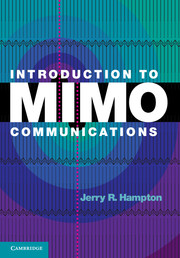Book contents
- Frontmatter
- Contents
- Preface
- 1 Overview of MIMO communications
- 2 The MIMO capacity formula
- 3 Applications of the MIMO capacity formula
- 4 RF propagation
- 5 MIMO channel models
- 6 Alamouti coding
- 7 Space-time coding
- 8 Spatial multiplexing
- 9 Broadband MIMO
- 10 Channel estimation
- 11 Practical MIMO examples
- Appendices
- References
- Index
8 - Spatial multiplexing
Published online by Cambridge University Press: 05 December 2013
- Frontmatter
- Contents
- Preface
- 1 Overview of MIMO communications
- 2 The MIMO capacity formula
- 3 Applications of the MIMO capacity formula
- 4 RF propagation
- 5 MIMO channel models
- 6 Alamouti coding
- 7 Space-time coding
- 8 Spatial multiplexing
- 9 Broadband MIMO
- 10 Channel estimation
- 11 Practical MIMO examples
- Appendices
- References
- Index
Summary
In this chapter, we turn our attention to the second major class of MIMO processing techniques: spatial multiplexing. As we discussed in Chapter 1, spatial multiplexing refers to transmitting multiple independent data streams over multipath channels, without the need to increase the bandwidth. Unlike space-time coding, which is used to achieve spatial diversity and which transmits at most one modulation symbol per modulation symbol period (i.e., rs ≤ 1), spatial multiplexing techniques are capable of achieving spatial rates equal to min {Nt,Nr}; that is, rather than only transmitting one or fewer modulation symbols per symbol period, spatial multiplexing involves transmitting up to min{Nt, Nr} modulation symbols per symbol period, resulting in a concomitant increase in throughput relative to spatial diversity schemes. This improvement in throughput, however, is achieved at the expense of diversity gain, so the diversity gains associated with spatial multiplexing methods are normally significantly less than NtNr. This chapter describes several fundamental, practical techniques that are used to achieve spatial multiplexing.
The chapter is divided into four sections. The first section presents an overview of spatial multiplexing concepts and reviews the major types of spatial multiplexing methods that have been proposed. The second section describes the transmit architectures associated with the class of SM schemes known as BLAST. Section 3 describes four spatial demultiplexing methods that can be used with H-BLAST and V-BLAST.
- Type
- Chapter
- Information
- Introduction to MIMO Communications , pp. 162 - 196Publisher: Cambridge University PressPrint publication year: 2013
- 1
- Cited by



